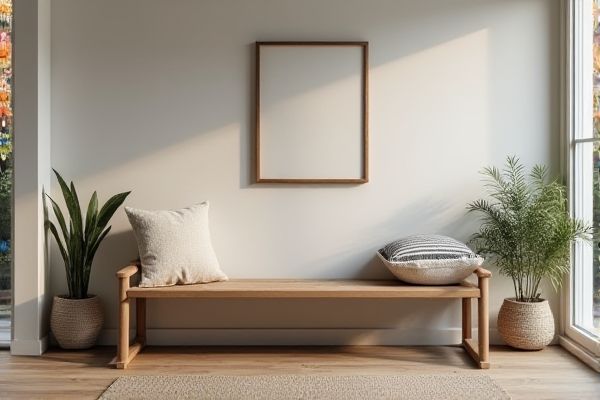
Folding benches offer portability and space-saving convenience by allowing you to collapse and store them easily, making them ideal for temporary seating needs. Stackable benches optimize storage by neatly piling multiple benches together, perfect for environments requiring quick reconfiguration; explore the rest of the article to find out which bench suits Your space best.
Table of Comparison
| Feature | Folding Bench | Stackable Bench |
|---|---|---|
| Design | Hinged, collapsible for easy folding | Uniform shape designed for vertical stacking |
| Storage | Compact when folded, minimal floor space | Stacks compactly, saves horizontal space |
| Portability | Highly portable and lightweight | Less portable due to bulk when stacked |
| Setup Time | Quick to fold and unfold | Low effort, just unstack |
| Durability | Varies by material, hinges may wear | Generally sturdy, stable stacking |
| Use Cases | Events, temporary seating, easy transport | Fixed venues, storage-heavy spaces |
| Cost | Moderate; hinges add complexity | Often lower; simpler design |
Introduction to Folding and Stackable Benches
Folding benches offer compact storage and easy transport through their hinged design, making them ideal for temporary seating in event spaces or outdoor activities. Stackable benches maximize space efficiency by allowing multiple units to be neatly piled, commonly used in schools, gyms, and multipurpose rooms for quick setup and breakdown. Choosing between folding and stackable benches depends on the specific needs for portability, storage capacity, and frequency of use.
Design Differences: Folding vs Stackable Benches
Folding benches feature a hinged design that allows legs or seats to collapse flat, optimizing portability and storage in compact spaces. Stackable benches have a sturdy frame and uniform shape, enabling multiple units to be securely piled vertically to save floor space efficiently. Your choice depends on whether ease of transport or maximizing stationary storage is the priority.
Space-Saving Advantages
Folding benches offer exceptional space-saving advantages by collapsing flat for easy storage in narrow spaces such as closets or under beds. Stackable benches maximize floor space by allowing multiple units to be neatly piled, reducing clutter in areas like classrooms or event halls. Both designs enhance efficient use of limited space, but folding benches provide more flexibility for compact storage while stackable benches enable quick access and organization.
Portability and Storage Comparison
Folding benches excel in portability due to their lightweight design and ability to collapse flat, making them ideal for easy transport and compact storage in tight spaces. Stackable benches prioritize efficient storage by allowing multiple units to be securely piled, optimizing floor space in warehouses or event venues. Choosing between the two depends on whether quick mobility or space-saving storage is the primary requirement.
Materials and Durability Factors
Folding benches are typically constructed from lightweight metals like aluminum or steel, paired with durable synthetic or wooden seats, designed for portability and easy storage without compromising strength. Stackable benches often feature robust hardwood or metal frames engineered to withstand frequent stacking and heavy use in communal or event settings, emphasizing long-term durability. The choice between folding and stackable benches depends on the balance between mobility needs and the required material resilience for specific environmental conditions.
Ease of Assembly and Use
Folding benches offer quick and effortless setup with hinged legs that collapse easily, making them ideal for frequent mobility and temporary seating needs. Stackable benches require minimal assembly but involve lifting and aligning multiple units for compact storage, which saves space in fixed locations. Your choice depends on whether you prioritize instant deployment or efficient long-term storage in your seating arrangement.
Weight Capacity and Stability
Folding benches typically offer moderate weight capacity with enhanced portability, making them suitable for temporary seating needs where ease of transport is prioritized. Stackable benches often provide higher weight capacity and superior stability due to their robust construction and fixed design, ideal for permanent or semi-permanent setups. Your choice should balance the need for mobility against the demand for durability and reliable support under heavier loads.
Maintenance and Cleaning Requirements
Folding benches require regular inspection of hinges and locking mechanisms to prevent rust and ensure smooth operation, while stackable benches demand frequent surface cleaning to avoid scratches and maintain finish quality. Both types benefit from materials like powder-coated steel or treated wood, which resist corrosion and dirt buildup, reducing overall maintenance efforts. Proper storage in dry environments minimizes wear and prolongs the lifespan of folding and stackable benches.
Best Use Cases for Folding Benches
Folding benches are ideal for situations requiring portability and compact storage, such as outdoor events, sports games, or temporary seating in small spaces. Their ability to collapse flat makes them perfect for frequent setup and teardown, maximizing convenience in your storage areas. You will find folding benches most useful when versatility and ease of transport are top priorities.
Ideal Applications for Stackable Benches
Stackable benches excel in environments requiring flexible seating arrangements, such as conference rooms, cafeterias, and event spaces. Their compact storage capability allows for easy reconfiguration and efficient use of limited space. You benefit from quick setup and teardown, making stackable benches ideal for dynamic and multifunctional areas.
 homyna.com
homyna.com